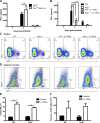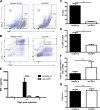Inflammatory monocytes require type I interferon receptor signaling to activate NK cells via IL-18 during a mucosal viral infection
- PMID: 28264883
- PMCID: PMC5379971
- DOI: 10.1084/jem.20160880
Inflammatory monocytes require type I interferon receptor signaling to activate NK cells via IL-18 during a mucosal viral infection
Abstract
The requirement of type I interferon (IFN) for natural killer (NK) cell activation in response to viral infection is known, but the underlying mechanism remains unclear. Here, we demonstrate that type I IFN signaling in inflammatory monocytes, but not in dendritic cells (DCs) or NK cells, is essential for NK cell function in response to a mucosal herpes simplex virus type 2 (HSV-2) infection. Mice deficient in type I IFN signaling, Ifnar-/- and Irf9-/- mice, had significantly lower levels of inflammatory monocytes, were deficient in IL-18 production, and lacked NK cell-derived IFN-γ. Depletion of inflammatory monocytes, but not DCs or other myeloid cells, resulted in lower levels of IL-18 and a complete abrogation of NK cell function in HSV-2 infection. Moreover, this resulted in higher susceptibility to HSV-2 infection. Although Il18-/- mice had normal levels of inflammatory monocytes, their NK cells were unresponsive to HSV-2 challenge. This study highlights the importance of type I IFN signaling in inflammatory monocytes and the induction of the early innate antiviral response.
© 2017 Lee et al.
Figures









Similar articles
-
Dual TLR2/9 Recognition of Herpes Simplex Virus Infection Is Required for Recruitment and Activation of Monocytes and NK Cells and Restriction of Viral Dissemination to the Central Nervous System.Front Immunol. 2018 Apr 30;9:905. doi: 10.3389/fimmu.2018.00905. eCollection 2018. Front Immunol. 2018. PMID: 29760708 Free PMC article.
-
Type I Interferon Receptor on NK Cells Negatively Regulates Interferon-γ Production.Front Immunol. 2019 Jun 4;10:1261. doi: 10.3389/fimmu.2019.01261. eCollection 2019. Front Immunol. 2019. PMID: 31214198 Free PMC article.
-
NK and NKT cell-independent contribution of interleukin-15 to innate protection against mucosal viral infection.J Virol. 2005 Apr;79(7):4470-8. doi: 10.1128/JVI.79.7.4470-4478.2005. J Virol. 2005. PMID: 15767447 Free PMC article.
-
Herpesviruses and the innate immune response.Viral Immunol. 2005;18(2):267-81. doi: 10.1089/vim.2005.18.267. Viral Immunol. 2005. PMID: 16035939 Review.
-
Immuno-metabolic changes in herpes virus infection.Cytokine. 2018 Dec;112:52-62. doi: 10.1016/j.cyto.2018.06.028. Epub 2018 Jun 28. Cytokine. 2018. PMID: 29960669 Review.
Cited by
-
A sustained type I IFN-neutrophil-IL-18 axis drives pathology during mucosal viral infection.Elife. 2021 May 28;10:e65762. doi: 10.7554/eLife.65762. Elife. 2021. PMID: 34047696 Free PMC article.
-
Thermal Stabilization of Viral Vaccines in Low-Cost Sugar Films.Sci Rep. 2019 May 21;9(1):7631. doi: 10.1038/s41598-019-44020-w. Sci Rep. 2019. PMID: 31113974 Free PMC article.
-
Early IFN-α signatures and persistent dysfunction are distinguishing features of NK cells in severe COVID-19.Immunity. 2021 Nov 9;54(11):2650-2669.e14. doi: 10.1016/j.immuni.2021.09.002. Epub 2021 Sep 4. Immunity. 2021. PMID: 34592166 Free PMC article.
-
Il4ra-independent vaginal eosinophil accumulation following helminth infection exacerbates epithelial ulcerative pathology of HSV-2 infection.Cell Host Microbe. 2021 Apr 14;29(4):579-593.e5. doi: 10.1016/j.chom.2021.02.004. Cell Host Microbe. 2021. PMID: 33857419 Free PMC article.
-
Systems analysis of immune responses to attenuated P. falciparum malaria sporozoite vaccination reveals excessive inflammatory signatures correlating with impaired immunity.PLoS Pathog. 2022 Feb 2;18(2):e1010282. doi: 10.1371/journal.ppat.1010282. eCollection 2022 Feb. PLoS Pathog. 2022. PMID: 35108339 Free PMC article. Clinical Trial.
References
-
- Baranek T., Manh T.P., Alexandre Y., Maqbool M.A., Cabeza J.Z., Tomasello E., Crozat K., Bessou G., Zucchini N., Robbins S.H., et al. . 2012. Differential responses of immune cells to type I interferon contribute to host resistance to viral infection. Cell Host Microbe. 12:571–584 (published erratum appears in Cell Host Microbe 2013. 13:372) . 10.1016/j.chom.2012.09.002 - DOI - PubMed
-
- Barr D.P., Belz G.T., Reading P.C., Wojtasiak M., Whitney P.G., Heath W.R., Carbone F.R., and Brooks A.G.. 2007. A role for plasmacytoid dendritic cells in the rapid IL-18-dependent activation of NK cells following HSV-1 infection. Eur. J. Immunol. 37:1334–1342. 10.1002/eji.200636362 - DOI - PMC - PubMed
Publication types
MeSH terms
Substances
Grants and funding
LinkOut - more resources
Full Text Sources
Other Literature Sources
Medical
Molecular Biology Databases
Miscellaneous

